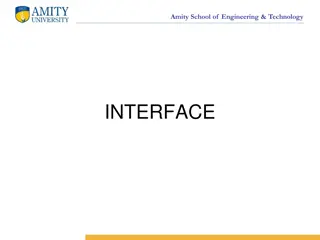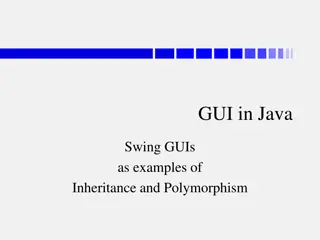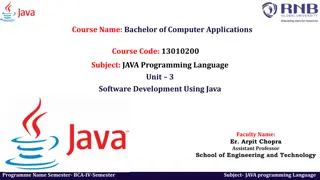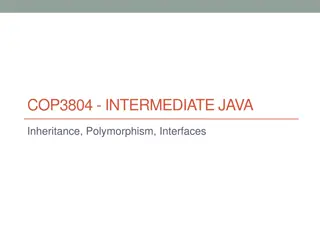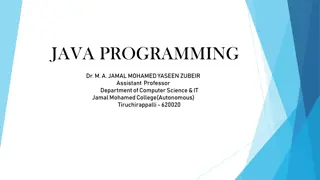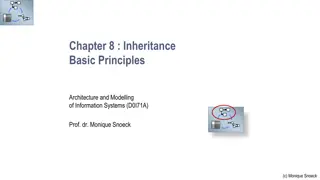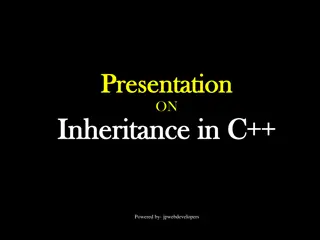INHERITANCE IN JAVA
Mechanism of deriving new classes from old classes is explained in Java through concepts like Single Inheritance, Multilevel Inheritance, Multiple Inheritance, and Hierarchical Inheritance. The process involves creating new classes known as Derived, Sub, or Child classes from existing Base, Super, or Parent classes. Various examples and diagrams illustrate how classes extend and inherit properties in Java programming. Additionally, topics like subclass constructors, the super keyword, and the challenges of multiple inheritance are covered.
Download Presentation

Please find below an Image/Link to download the presentation.
The content on the website is provided AS IS for your information and personal use only. It may not be sold, licensed, or shared on other websites without obtaining consent from the author. Download presentation by click this link. If you encounter any issues during the download, it is possible that the publisher has removed the file from their server.
E N D
Presentation Transcript
Inheritance in Java Mechanism of deriving new class from old class. The old class is known as- Base Class / Super class / Parent Class The new class is known as- Derived class/ Sub Class / Child class Types: Single Inheritance Multilevel Inheritance Multiple inheritance Hierarchical Inheritance 1. 2. 3. 4.
Inheritance In Java Single inheritance - When a class extends another one class only then we call it a single inheritance. The below flow diagram shows that class B extends only one class which is A. Here A is a parent class of B and B would be a child class of A. A B
Single Inheritance example program in Java Class A { public void methodA() { System.out.println("Base class method"); } } Class B extends A { public void methodB() { System.out.println("Child class method"); } public static void main(String args[]) { B obj = new B(); obj.methodA(); //calling super class method obj.methodB(); //calling local method } }
Sub Class Constructor A subclass constructor is used to construct the instance variables of both the subclass and the superclass. The subclass constructor uses the keyword superto invoke the constructor method of superclass. The super Keyword is used with following Conditions super may only be used within a subclass constructor. The call to super must appear as first statement. Parameters in the super call must match with declaration in superclass
class Vehicle { } class Bike extends Vehicle{ Bike() { super();//will invoke parent class constructor System.out.println("Bike is created"); } public static void main(String args[]){ Bike b=new Bike(); } } Vehicle() { System.out.println("Vehicle is created"); }
Multiple Inheritance Multiple Inheritance refers to the concept of one class extending (Or inherits) more than one base class. The problem with multiple inheritance is that the derived class will have to manage the dependency on two base classes. A B C
Multilevel Inheritance Multilevel inheritance refers to a mechanism in OO technology where one can inherit from a derived class, thereby making this derived class the base class for the new class. As you can see in below flow diagram C is subclass or child class of B and B is a child class of A. A B C
Class X { } Class Y extends X { public void methodY() { } } Class Z extends Y { public void methodZ() { } public static void main(String args[]) { Z obj = new Z(); obj.methodX(); //calling grand parent class method obj.methodY(); //calling parent class method obj.methodZ(); //calling local method } } public void methodX() { System.out.println("Class X method"); } System.out.println("class Y method"); System.out.println("class Z method");
Hierarchical Inheritance In such kind of inheritance one class is inherited by many sub classes. In below example class B,C and D inherits the same class A. A is parent class (or base class) of B,C & D. A B C D
Class A { } Class B extends A { public void methodB() { System.out.println("method of Class B"); } } Class C extends A { public void methodC() { System.out.println("method of Class C"); } } public void methodA() { System.out.println("method of Class A"); }
Class D extends A { public void methodD() { System.out.println("method of Class D"); } } Class MyClass { public static void main(String args[]) { B obj1 = new B(); C obj2 = new C(); D obj3 = new D(); obj1.methodA(); obj2.methodA(); obj3.methodA(); }} `
Overriding Methods If subclass (child class) has the same method as declared in the parent class, it is known as method overriding. In other words, If subclass provides the specific implementation of the method that has been provided by one of its parent class, it is known as Method Overriding. Advantage of Java Method Overriding provide specific implementation of a method that is already provided by its super class. Rules for Method Overriding method must have same name as in the parent class method must have same parameter as in the parent class. must be IS-A relationship (inheritance).
Example class Vehicle { } class Bike extends Vehicle { void run() { } public static void main(String args[]) { Bike obj = new Bike(); obj.run(); } } void run() { } System.out.println("Vehicle is running"); System.out.println("Bike is running safely");
class Bank{ int getRateOfInterest() {return 0;} } class SBI extends Bank{ int getRateOfInterest() {return 8;} } class ICICI extends Bank{ int getRateOfInterest() {return 7;} } System.out.println("SBI Rate of Interest: "+s.getRateOfInterest()); System.out.println("ICICI Rate of Interest: "+i.getRateOfInterest()); } class Test{ public static void main(String args[]){ SBI s=new SBI(); ICICI i=new ICICI();
Method Overloading Method Overriding 1) Method overloading is used to increase the readability of the program. Method overriding is used to provide the specific implementation of the method that is already provided by its super class. 2) method overloading is performed within a class. Method overriding occurs in two classes that have IS-A relationship. 3) In case of method overloading parameter must be different. In case of method overriding parameter must be same.
Final variables and Methods All methods and variables can be overridden by default in subclasses. To prevent the subclasses from overriding the members of the superclass, declare them as final using final keyword. final int SIZE=10; final void showstatus(..) { } Defining method final ensures that functionality of defined method will not be altered. Similarly the value of final variable never be changed.
Final Classes A class that can not be sub-classed is called final class. final class Aclass { } final class Bclass extends Someclass { }
Finalizer Methods Constructors are used to initialize an object when it is declared. This process is known as Initialization . Similarly, java supports a concept called finalization . Java run time is automatic garbage collecting system. It automatically frees up the memory resources used by the objects. But objects may hold other non-object resources. To free these resources we must use a finalizer method finalize( )
Abstract Methods and Classes A class declared as abstract is known as abstract class. It needs to be extended and its method implemented. It cannot be instantiated. Syntax to declare the abstract class abstract class <class_name>{ } Abstract Method A method that is declared as abstract and does not have implementation is known as abstract method. Syntax to define the abstract method abstract return_type <method_name>(); //no braces{}
Example abstract class Bike{ } abstract void run( ); class Honda extends Bike { void run() { } System.out.println("running safely.."); public static void main(String args[]) { Bike obj = new Honda(); obj.run(); } }
//example of abstract class having constructor, field and method abstract class Bike { int limit=30; Bike( ) { System.out.println("constructor is invoked"); } void getDetails() { System.out.println("it has two wheels"); } abstract void run(); } class Honda extends Bike{ void run(){ System.out.println("running safely.."); } public static void main(String args[]){ Bike obj = new Honda(); obj.run(); obj.getDetails(); System.out.println(obj.limit); } }
Methods with Varargs Varargs represents variable length arguments in methods. It makes the code simpler and flexible. <access specifier> void method-name(object arguments) In this syntax, the method contains an argument called varargs ,in which Object is type of an argument. Ellipsis ( ) is the key to varargs and arguments is the name of variable.
Thus varargs allows us to declare a method with the unspecified number of parameters. The varargs must be the final argument in the argument list of a method. Example : Public void sample(String username, String password, String mailId); This method can be replaced by varargs: public void sample(String var_name)
Example program for varargs class Exampleprg { Exampleprg (String person) { for(String name: person) { System.out.println( Hello + name); } } public static void main(String args[]) { Exampleprg( John , Janny , Janardan ); } }
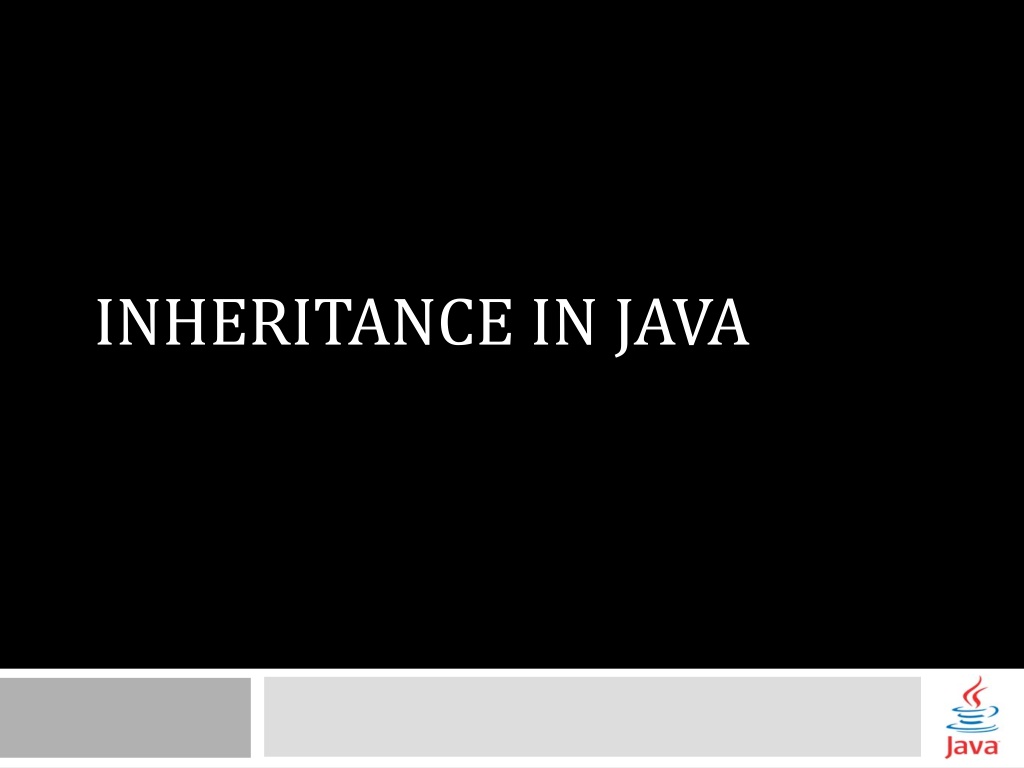
 undefined
undefined








